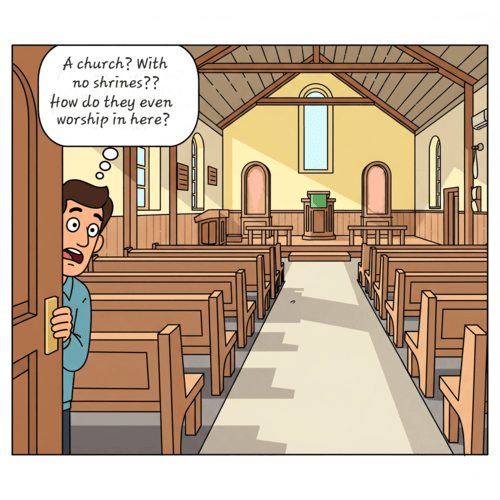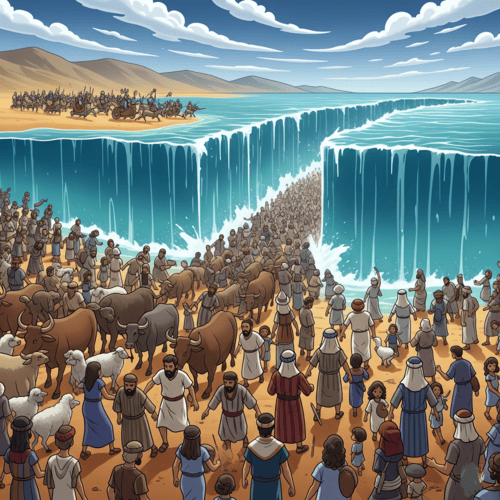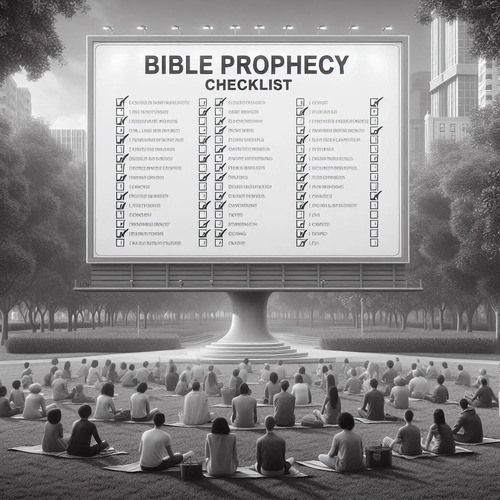The Fall of Jericho: Does Archaeology Back the Bible Account?
Few biblical stories of conquest capture the imagination quite like the fall of Jericho does—where walls came tumbling down at the sound of trumpets and shouts. This dramatic account has been a flashpoint in debates between archaeology and Scripture for decades. While sceptics have questioned its historicity, recent archaeological discoveries continue to provide compelling evidence that affirms the biblical narrative.
THE FALL OF JERICHO: THE BIBLICAL ACCOUNT
The Book of Joshua provides a detailed account of Israel’s conquest of Jericho. On crossing the Jordan River, Joshua encounters the Commander of the Lord’s army (Joshua 5:13-15)—believed to be a theophany. God commands the Israelites to march around the city once daily for six days, with seven priests carrying trumpets before the ark. On the seventh day, they were to march around the city seven times, followed by the priests blowing the trumpets and the people shouting loudly—at which point the walls would collapse (Joshua 6:1-5).
The narrative continues with the Israelites faithfully following these instructions (Joshua 6:20-21), sparing only Rahab and her family due to her faith in protecting the Israelite spies.
Before departing, Joshua even pronounces a solemn curse: “Cursed before the LORD is the one who undertakes to rebuild this city, Jericho: At the cost of his firstborn son he will lay its foundations; at the cost of his youngest he will set up its gates” (Joshua 6:26).
ARCHAEOLOGICAL DISCOVERIES AT TELL ES-SULTAN
Modern archaeology has identified ancient Jericho with Tell es-Sultan, a settlement mound near present-day Jericho. Multiple archaeological expeditions have excavated this site over the past century, with sometimes conflicting conclusions.
- In the 1930s, Dr. John Garstang conducted extensive excavations, discovering evidence of a destroyed city with walls that had apparently collapsed outward—precisely what one would expect if they fell as described in Joshua. Garstang dated this destruction layer to around 1400 BC, aligning closely with biblical chronology.
- In the 1950s, British archaeologist Kathleen Kenyon challenged these findings. Her excavations led her to conclude the city had been destroyed much earlier, around 1550 BC, well before the traditional date of the Israelite conquest. The apparent discrepancy became a cornerstone of sceptical arguments against the biblical account.
- In the 1990s: The debate took a significant turn again in the 1990s, when archaeologist Bryant Wood re-examined Kenyon’s findings. Wood identified flaws in Kenyon’s pottery dating methods and argued her own evidence actually supported a destruction date around 1400 BC—consistent with the biblical timeline. Wood pointed to Canaanite pottery, scarabs (Egyptian amulets), and carbon-14 dating that aligned with biblical chronology.
Recent excavations and scientific dating methods continue to provide evidence suggesting Jericho’s destruction occurred closer to the biblically consistent date than Kenyon concluded.
KEY ARCHAEOLOGICAL EVIDENCE SUPPORTING THE BIBLE ACCOUNT
Several specific archaeological findings lend credence to the Bible narrative:
- Collapsed Walls: Excavations have revealed Jericho’s walls collapsed outward, not inward as would be expected from typical siege warfare. The unusual pattern matches exactly what would occur if the walls fell as described in Scripture. John Garstang specifically documented this phenomenon in his excavation reports (The Foundations of Bible History: Joshua, Judges, 1931). He writes “the walls fell outwards so completely that the attackers would be able to clamber up and over their ruins into the city.” This finding was later referenced and analysed in Bryant Wood’s comprehensive reassessment published in the Biblical Archaeology Review (March/April 1990).
- Evidence of Intense Fire: Archaeologists discovered a layer of burned ash up to three feet thick, confirming the biblical statement that “they burned the whole city and everything in it” (Joshua 6:24). This extensive burn layer was documented in both Garstang’s 1930s excavation reports (The Story of Jericho, 1948) and later confirmed in Kenyon’s detailed stratigraphic analysis (Excavations at Jericho, Vol. 3, 1981). The intensity and extent of this burn layer indicates a deliberate and comprehensive destruction rather than an accidental fire.
- Grain Storage: One of the most telling discoveries was large quantities of stored grain found among the ruins, first reported by Garstang and later analysed in detail by Bryant Wood (Biblical Archaeology Review, March/April 1990, “Did the Israelites Conquer Jericho?”). Wood noted “houses along the west side of the tell were found to contain large quantities of grain,” a truly remarkable find since grain was highly valuable in the ancient world. This evidence indicates two critical points: First, the city fell in spring shortly after harvest (aligning with the biblical timing at Passover in Joshua 5:10); second, the attackers did not plunder the valuable grain as would be expected in normal warfare—consistent with God’s command that the city be “devoted to destruction” with no plunder taken. Kenyon herself wrote in her excavation reports that the destruction was “complete” and occurred at the “end of the Middle Bronze Age, at a time when the town’s stores of grain had just been harvested” (Digging Up Jericho, 1957).
- Unplundered State: Despite being burned, many valuable items remained in the ruins, suggesting the city wasn’t plundered in the conventional manner of ancient warfare but destroyed in accordance with divine instruction.
- Occupational Gap: Archaeological evidence indicates a significant period without settlement following the destruction, consistent with the curse against rebuilding the city.
THE FALL OF JERICHO: ADDRESSING ARCHAEOLOGICAL CHALLENGES
The primary challenge to the biblical account comes from dating controversies. The debate centres on whether Jericho was destroyed in the Middle Bronze Age (around 1550 BC) or the Late Bronze Age (around 1400 BC)—the latter being consistent with biblical chronology.
Traditional archaeological methods have limitations, particularly when it comes to precise dating. Recent reanalysis of pottery types, stratigraphic evidence, and carbon-14 dating has challenged previous conclusions. Some archaeologists have proposed recalibrated chronologies that better align the archaeological evidence with biblical accounts.
It’s also worth noting that archaeology can only uncover what has survived—and much hasn’t. Absence of evidence is not evidence of absence, particularly at a site like Jericho that has been repeatedly excavated, rebuilt, and exposed to natural erosion for millennia.
THE CURSE AND ITS FULFILLMENT
Joshua’s prophetic curse against rebuilding Jericho provides another remarkable connection between Scripture and historical evidence (Joshua 6:26).
Approximately 500 years later, during the reign of King Ahab, the Bible records the fulfilment of this prophecy (1 Kings 16:34).
Archaeological evidence confirms a significant occupational gap at Tell es-Sultan, showing minimal settlement between its destruction and later rebuilding attempts. Small, unfortified settlements may have existed in the area during this period, but not a rebuilt fortified city on the original site.
Modern Jericho is built adjacent to, but not directly on top of, the ancient tell—perhaps an unconscious acknowledgment of the power of Joshua’s curse. The pattern of avoiding rebuilding directly on sites of divine judgement appears elsewhere too in biblical archaeology, such as at Sodom and Gomorrah.
THEOLOGICAL IMPLICATIONS
The archaeological evidence surrounding Jericho speaks to God’s faithfulness in fulfilling His promises. The conquest of Canaan was promised to Abraham centuries earlier, and the fall of Jericho demonstrates God’s sovereign control over history in bringing this promise to fulfilment.
Joshua’s leadership exemplifies faith and obedience even when God’s methods seem unconventional by human standards. The archaeological evidence doesn’t “prove” faith, but it confirms that our faith is rooted in real historical events, not myths or legends.
The reliability of these historical accounts strengthens our confidence in God’s covenant promises. If God was faithful to fulfil His word regarding Jericho’s fall and the curse against its rebuilding, we can trust Him to be faithful to all His promises, including those regarding salvation and Christ’s return.
THE FALL OF JERICHO: CONCLUSION
The walls of Jericho continue to speak today through both Scripture and archaeology. While challenges to the biblical account remain, the archaeological evidence increasingly supports the historical reliability of Joshua’s account. The fallen walls, burned city, untouched grain stores, and long period without rebuilding all align with the biblical narrative.
As believers, we don’t base our faith on archaeological discoveries, but we can take confidence that God’s Word stands firm even under the scrutiny of modern science.
FURTHER RESOURCES
For those interested in exploring this topic further, consider these resources:
- The Walls of Jericho by Bryant G Wood (Biblical Archaeology Review)
- On the Reliability of the Old Testament by KA Kitchen
- Ancient Israel: What Do We Know and How Do We Know It? by Lester L Grabbe
- The Story of Jericho by John Garstang and JBE Garstang (Marshall, Morgan & Scott, 1948)
- Jericho: The Evidence of the Literary Tradition, of History, and of Archaeology by JM Miller (Palestine Exploration Quarterly, 1977)
THE FALL OF JERICHO: RELATED FAQs
How large was ancient Jericho during the time of Joshua? Ancient Jericho was surprisingly small by modern standards, covering only about 6-8 acres (approximately 3 football fields). Despite its small size, it was heavily fortified with double walls and was strategically important as the “gateway to Canaan,” controlling access to the central hill country where much of Israel would eventually settle. Archaeological excavations indicate it housed perhaps 1,500-2,500 residents.
- What happened to Rahab after Jericho’s destruction? Scripture tells us Rahab and her family were spared and “she lives among the Israelites to this day” (Joshua 6:25). According to Matthew 1:5, Rahab married Salmon of the tribe of Judah and became an ancestor of King David and eventually Jesus Christ. Her transformation from Canaanite prostitute to honoured matriarch in Israel’s lineage demonstrates God’s redemptive grace that transcends ethnic and moral boundaries.
- Why did God command complete destruction of Jericho rather than allowing Israel to inhabit it? Jericho was designated as the “firstfruits” of the Promised Land conquest, devoted entirely to God (Joshua 6:17-19). This practice, called herem in Hebrew, meant the city was set apart for complete destruction as an act of worship and acknowledgment that victory came from God, not human strength. Additionally, God had pronounced judgement on the Canaanites for generations of idolatry and moral corruption, with archaeological evidence revealing widespread child sacrifice and ritual prostitution in Canaanite culture.
Have other ancient cities been found with walls that collapsed outward like Jericho’s? The outward collapse of city walls is an extremely rare archaeological phenomenon, as siege warfare typically causes walls to collapse inward when attackers breach them. Few if any other ancient Near Eastern cities show this distinctive pattern of outward wall collapse that Garstang and Wood documented at Jericho. This unique feature aligns perfectly with the biblical description of walls “falling flat” (Joshua 6:20), consistent with supernatural intervention rather than conventional military tactics.
- What was the significance of marching around Jericho for seven days? The seven-day march around Jericho carried deep symbolic meaning in ancient Israelite culture. Seven represented divine completeness and perfection, while the Ark of the Covenant represented God’s presence among His people. This unusual military strategy demonstrated Israel’s trust in God’s power rather than conventional warfare tactics and emphasised the victory belonged to God alone, not human strength. It also served as a theological statement to both Israelites and Canaanites that Yahweh, not local Canaanite deities, controlled the fate of cities and nations.
- How does the conquest of Jericho compare to other ancient conquest accounts? Unlike typical ancient conquest accounts that glorify the king’s strength and military prowess, the biblical Jericho narrative emphasises Israel’s weakness and God’s supernatural intervention. Most ancient Near Eastern victory monuments and texts describe brutality and plundering as signs of royal power, while Joshua portrays Israel as merely obedient to God’s commands, with strict prohibitions against taking plunder. Archaeological evidence confirms this unique pattern, as valuable items remained unplundered in the ruins, contradicting normal ancient warfare practices where armies sustained themselves through plunder.
How did early Christian interpreters understand the Jericho account? Early Church Fathers, Origen, Augustine, and Jerome saw the Jericho conquest as both historical and typological, prefiguring spiritual realities. They interpreted the seven-day march and trumpets as foreshadowing gospel proclamation breaking down spiritual strongholds. The New Testament itself provides this interpretative framework in Hebrews 11:30, including Jericho in the “hall of faith” and emphasising “by faith the walls of Jericho fell.” The early church understood the historical reality of Jericho served as a “shadow” pointing to greater spiritual warfare against sin and darkness.
THE FALL OF JERICHO: OUR RELATED POSTS
- Validating Bible History: Archaeological Finds in Judah
- Truth to the Test: Can Geography Validate Bible Accounts?
- Hezekiah’s Reforms: Lachish Discoveries Confirm Bible Account
- Bible Accounts of Ancient Trade: Archaeological Evidence
- Historical Reliability of the Bible: Astonishing Archaeological Finds
- Archaeology Endorses Scripture: Papyri and Dead Sea Scrolls
Editor's Pick

Self-Authentication: Why Scripture Doesn’t Need External Validation
"How can the Bible prove itself? Isn't that circular reasoning?" This objection echoes through university classrooms, coffee shop discussions, and [...]

Do Christians Need Holy Shrines? Why the Reformed Answer Is No
Walk into a medieval cathedral and you'll encounter ornate shrines, gilded reliquaries, and designated "holy places" where pilgrims gather to [...]

I Want To Believe, But Can’t: What Do I Do?
"I want to believe in God. I really do. But I just can't seem to make it happen. I've tried [...]

BC 1446 or 1250: When Did the Exodus Really Happen?
WHY REFORMED SCHOLARS SUPPORT THE EARLY DATE Many a critic makes the claim: “Archaeology has disproven the biblical account [...]

Does God Know the Future? All of It, Perfectly?
Think about this: our prayers tell on us. Every time we ask God for something, we’re confessing—often without realising it—what [...]

Can Christian Couples Choose Permanent Birth Control?
Consider Sarah, whose fourth pregnancy nearly killed her due to severe pre-eclampsia, leaving her hospitalised for months. Or David and [...]

Bone of My Bones: Why Eve Was Created From Adam’s Body
"This at last is bone of my bones and flesh of my flesh!" Adam's joyful exclamation upon first seeing Eve [...]

Is Calvinism Fatalism in Christian Disguise? Think Again
We hear the taunt every now and then: "Calvinism is just fatalism dressed up in Christian jargon." Critics argue Reformed [...]

Can Churches Conduct Same-Sex Weddings?
In an era of rapid cultural change, churches across America face mounting pressure to redefine their understanding of marriage. As [...]

Gender Reassignment: Can Christian Doctors Perform These Surgeries?
In the quiet of a clinic, a Christian physician faces a challenging ethical question. A patient sits across the desk, [...]
SUPPORT US:
Feel the Holy Spirit's gentle nudge to partner with us?
Donate Online:
Account Name: TRUTHS TO DIE FOR FOUNDATION
Account Number: 10243565459
Bank IFSC: IDFB0043391
Bank Name: IDFC FIRST BANK






